6th Grade measuring units worksheets: Free Download
Are your 6th graders comfortable working with different units of measurement? Do you need engaging and effective worksheets to help your sixth graders master measuring units? If so, you've come to the right place! In this article, we'll share a free download of 6th-grade measuring units worksheets from Mathskills4kids.com with activities covering sixth-grade math's most essential measuring units: length, mass, volume, and time.
-
Your 6th graders will also learn why measuring units is essential for understanding math and science concepts, converting between different units using ratios and proportions, and applying their conversion skills to real-world problems. Plus, we'll give you some fun activities that you can use to reinforce measuring unit concepts with games and puzzles.
By the end of this article, you'll have everything you need to help your students ace their sixth-grade measurement units skills!
Fun and engaging measurement conversion activities for 6th Graders
Measuring units are the primary tools we use to quantify and compare different quantities in math and science. For example, we use measuring units to measure how long something is, how much it weighs, how much space it occupies, and how long it takes to do something. That is why Mathskills4kids.com has designed these fun and engaging measurement conversion activities to help 6th Graders understand the relationship between units of measurement.
Measuring units help us communicate accurately and precisely about the world around us. They also help us solve problems involving calculations and comparing different quantities.
-
BROWSE THE WEBSITE
-
DOWNLOAD FREE WORKSHEETS
-
-
GRADE 6 MATH TOPICS
- Whole numbers
- Multiplication
- Division
- Exponents and square roots
- Number theory
- Decimals
- Add & subtract decimals
- Multiply & divide decimals
- Fractions & mixed numbers
- Add & subtract fractions
- Multiply fractions
- Divide fractions
- Integers
- Operations with integers
- Mixed operations
- Rational numbers
- Problems solving
- Ratio & proportions
- Percentages
- Measuring units
- Money math
- Consumer math
- Telling time
- Coordinate graph
- Algebraic expressions
- One step equations
- Solve & graph inequalities
- Two-step equations
- 2D Geometry
- Symmetry & transformation
- 3D Shapes
- Geometry measurement
- Data and Graphs
- Statistics
- Probability
-
-
Estimating length customary units practice
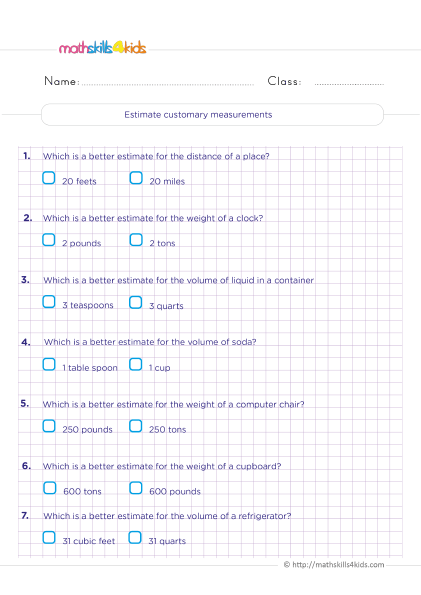 Print it...
Print it...
-
Estimating metric measurements exercises with answers
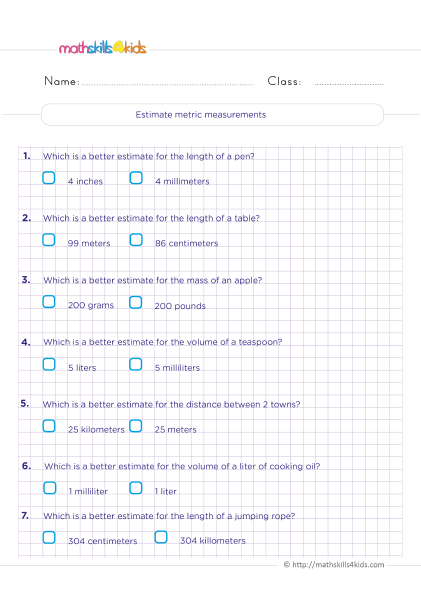 Print it...
Print it...
-
Customary unit conversions involving fractions and mixed numbers
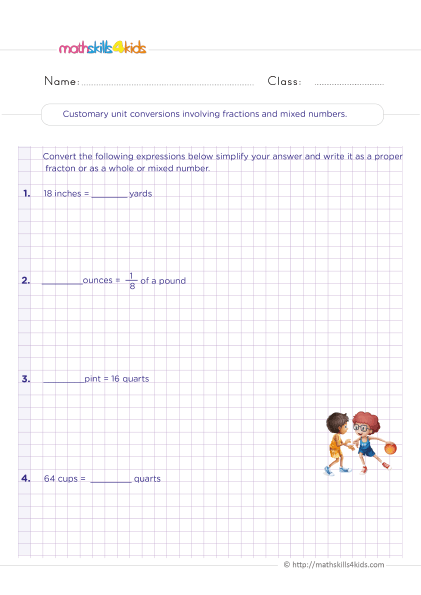 Print it...
Print it...
-
Comparing and converting metric units practice
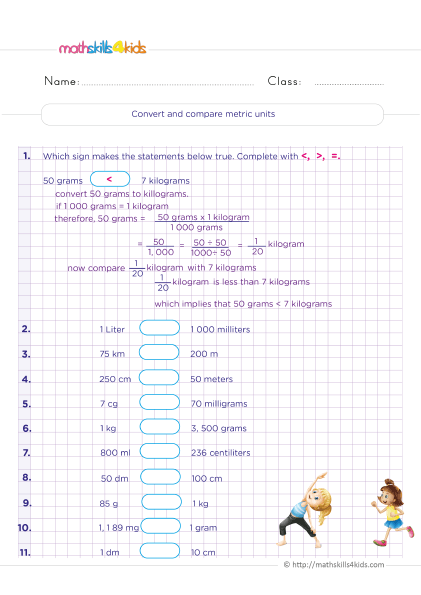 Print it...
Print it...
-
Compare temperature: negative and positive number comparison
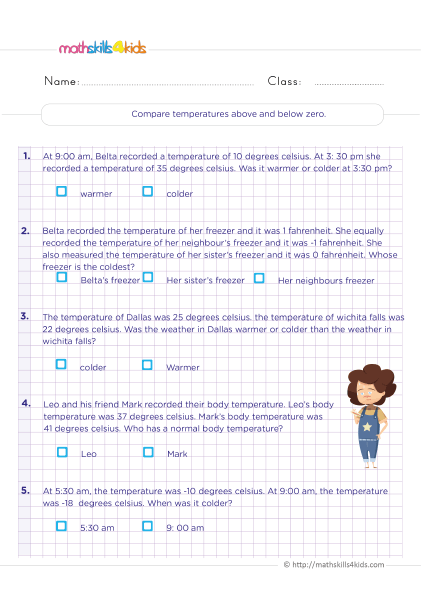 Print it...
Print it...
-
Converting between celcius and fahrenheit
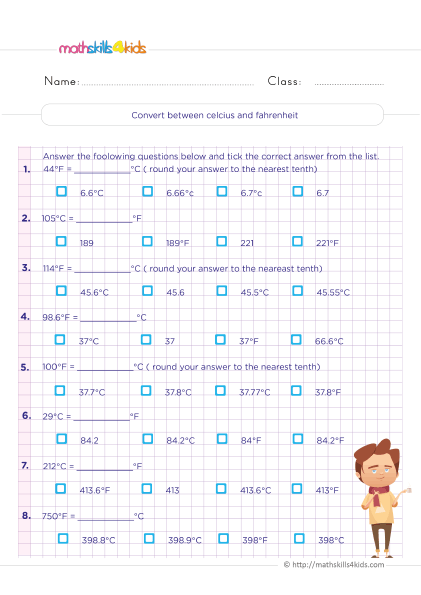 Print it...
Print it...
-
Estimating length customary units practice
-
Buying is supporting us!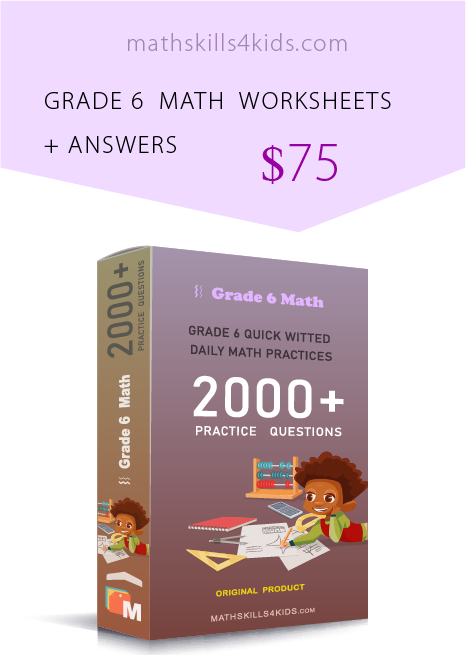
Buy Now...
-
-
Why measuring units matter
Measuring units matter greatly as they help us solve many math, science, and everyday problems. For instance, when shopping, you must know how much things cost per unit (such as dollars per pound or cents per ounce). When you cook or bake, you must know how to measure ingredients using cups, teaspoons, tablespoons, etc.
When traveling, you need to know how to convert between different units of distance (such as miles and kilometers) and time (such as hours and minutes).
Measuring units are everywhere, and knowing how to use them correctly can make our lives easier and more efficient.
-
Review of basic measuring units: Length, Mass, Volume, and Time
In sixth-grade math, students will learn about four basic types of measuring units: length, mass, volume, and time.
Length is the measure of how long something is. The most common units of length are meters (m), centimeters (cm), millimeters (mm), kilometers (km), inches (in), feet (ft.), yards (yd.), and miles (mi).
Mass is the measure of how much matter something has. The most common units of mass are grams (g), kilograms (kg), milligrams (mg), tons (t), ounces (oz.), pounds (lb.), and stones (st).
Volume is the measure of how much space something occupies. The most common units of volume are liters (L), milliliters (mL), cubic meters (m3), cubic centimeters (cm3), gallons (gal), quarts (qt), pints (pt.), cups (c), fluid ounces (fl oz.), and teaspoons (tsp).
Time is the measure of how long something lasts or takes. The most common units of time are seconds (s), minutes (min), hours (h), days (d), weeks (w), months (mo.), years (y), and centuries (c).
-
How to convert between different measuring units using ratios and proportions
One of the most vital skills students will learn in sixth-grade math is converting between different measuring units using ratios and proportions.
A ratio is a comparison of two quantities using division. For example, the ratio of 12 inches to 1 foot is 12/1 or 12:1.
A proportion is an equation that shows that two ratios are equal. For example, the proportion 12/1 = 24/2 shows that the ratio of 12 inches to 1 foot equals the ratio of 24 inches to 2 feet.
We must know the conversion factor between the units to convert between different measuring units using ratios and proportions. A conversion factor is a fraction that shows how many units of one type equal one unit of another type.
For example, the conversion factor from inches to centimeters is 2.54/1 or 2.54:1, which means that 2.54 centimeters are equal to 1 inch. To use a conversion factor to convert between units, we multiply the given quantity by the conversion factor that has the unit needed on top and the unit available on bottom.
For example, to convert 15 inches to centimeters, we multiply 15 by 2.54/1:
15 x 2.54/1 = 38.1 cm
-
Mastering metric and customary unit conversions – best enhance measurement and estimation skills
Before mastering metric and customary unit conversions, kids have to be reminded that these units relate to measuring length, weight, capacity, time, etc. The table below presents the equivalence between metric and customary unit. This strategy will best enhance measurement and estimation skills in your kids.
Customary unit
Metric unit
1 inch
25.4 millimeters
1 foot
30.48 centimeters
1 yard
0.91 meter
1 mile
1.61 kilometers
1 teaspoon
4.93 milliliters
1 cup
0.24 liter
1 pint
0.47 liter
1 quart
0.95 liter
1 gallon
3.79 liters
1 ounce
28.35 grams
1 pound
0.45 kilogram
-
Practice problems in 6th Grade measuring units worksheets: Applying conversion skills to real-world scenarios.
To help students practice and apply their conversion skills to real-world scenarios, Mathskills4kids.com has prepared six 6th-grade measuring unit worksheets containing real-world problems involving measuring units. Each worksheet focuses on one type of unit: length, mass, volume, or time.
Your 6th-grade students will use ratios and proportions to convert between different units and solve the problems. For example, one of the problems on the length worksheet is:
A map has a scale of 1 cm: 5 km. How far apart are two cities, 8 cm apart on the map?
To solve this problem, we’ll use the conversion factor from centimeters to kilometers, which is 5/1 or 5:1, and multiply 8 by 5/1:
8 x 5/1 = 40 km
The answer is 40 kilometers.
-
Fun activities: Games and puzzles to reinforce measuring unit concepts
To make learning about measuring units more fun and engaging, we've also included some games and puzzles that you can use to reinforce the concepts. These fun activities are designed to help 6th graders review the different types of units, practice conversions, and apply their skills to real-world situations.
For example, one of the games is bingo, where students have to match different units of the same type (such as meters and feet) or different types (such as liters and cups).
Another game is a crossword puzzle where students fill in the blanks with the correct units or conversion factors.
Children can play these games with their classmates, friends, or family and have fun while learning!
Bonus: Additional resources to reinforce 6th-graders’ measurement unit skills
If you want your 6th Grade students to practice more on measurement units and reinforce their skills, here are some useful web links with descriptions that you can check out:
- https://www.mathsisfun.com/measure/index.html: This website has interactive lessons and quizzes on various topics related to measurements, such as units, length, area, volume, time, temperature, and angles. You can also find fun games and puzzles to test your student’s knowledge.
- https://www.khanacademy.org/math/cc-sixth-grade-math/cc-6th-expressions-and-variables/cc-6th-units/a/units: This website has videos and exercises on how to use units in math problems. 6th graders can learn how to convert between different units, use dimensional analysis, and check the reasonableness of their answers.
- https://www.education.com/games/measurement/: This website has a collection of online games that let students practice measurement skills in a fun way. They can play games such as Measuring Length in Inches, Measuring Volume in Cubic Units, Measuring Angles with a Protractor, and more.
-
-
Thank you for sharing the links of MathSkills4Kids.com with your loved ones. Your choice is greatly appreciated.
Conclusion: How to use these worksheets effectively
We hope you find Mathskills4kid’s worksheets valuable and helpful for your sixth-grade math studies. To use these worksheets effectively, we suggest that students follow these steps:
- Review the basic measuring units and conversion factors before working on the worksheets.
- Read each problem carefully and identify what type of unit you have and what type of unit you need.
- Use ratios and proportions to convert between units and solve the problems.
- Check your answers with the answer key and correct any mistakes.
- Try the games and puzzles to review and reinforce what you learned.
By following these steps, your 6th-grade math students will be able to master measuring units in no time! Remember, measuring units are essential for math, science, and everyday life. Using them correctly can make our lives easier and more efficient.
So, don't wait any longer and download Mathskills4kids’ 6th Grade measuring units worksheets today and give your kids the best practice!
